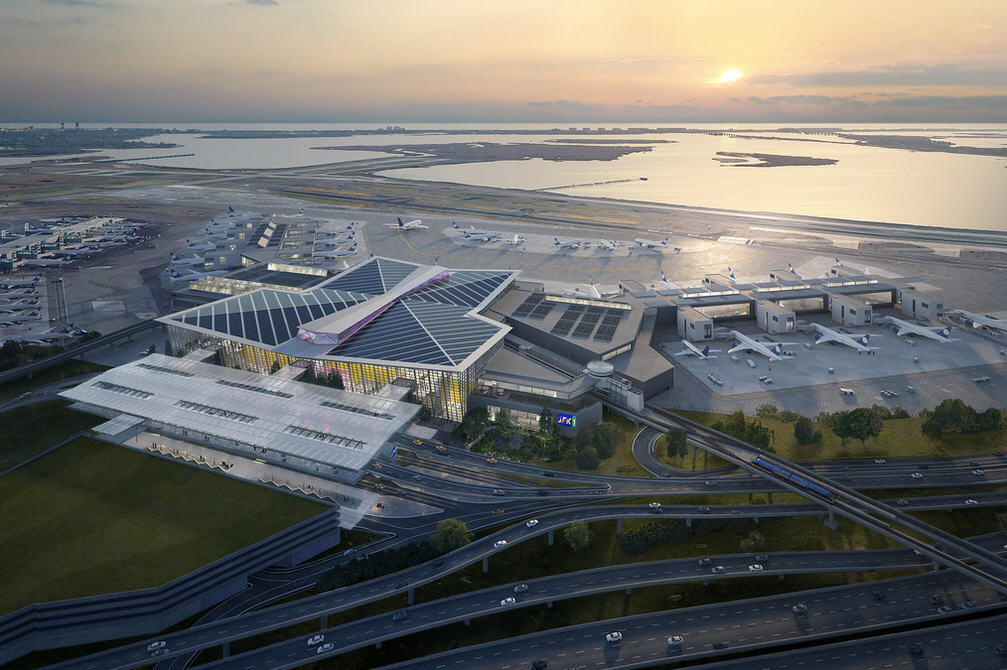
Governor Kathy Hochul recently unveiled plans for a groundbreaking development at New York’s John F. Kennedy International Airport. The project, a collaborative effort with private partners, will introduce a cutting-edge 2.4 million square foot international terminal set to revolutionize the south side of the airport. This $9.5 billion initiative marks a significant step in the comprehensive transformation of JFK Airport, aiming to create a world-class travel hub equipped with top-tier amenities and state-of-the-art security measures.
The Port Authority of New York and New Jersey, in collaboration with The New Terminal One (NTO) consortium, comprising financial backers Carlyle, JLC Infrastructure, and Ullico, is spearheading this ambitious endeavor. The consortium, joined by Munich Airport International and CAG Holdings, aims to fund the entire terminal privately.
This groundbreaking project will span multiple phases, strategically utilizing the sites of the current Terminal 1, the outdated Terminal 2, and the former Terminal 3. The new terminal will boast an arrivals and departures hall and an initial set of gates projected to commence operations by 2026, with full completion anticipated around 2030.
Governor Hochul emphasized the creation of over 10,000 jobs, including more than 6,000 construction roles, aligning with the mission to revitalize the airport. The initiative prioritizes local business opportunities and job creation, guided by a dedicated Community Advisory Council.
The architectural marvel will encompass 23 new gates, cutting-edge security measures, and eco-friendly practices, leveraging renewable energy technologies. The terminal’s design emphasizes a New York-inspired ambiance, integrating local art, dining, and retail spaces to elevate the traveler experience.
The phased construction plan adapts to international passenger traffic levels, ensuring a sustainable and efficient development aligned with evolving travel demands. This forward-looking approach reflects a resolute commitment to transform JFK into a unified global gateway for the 21st century.
The Port Authority’s board will vote on the proposed lease agreement, marking a pivotal moment in the project’s progression. Moreover, the authority plans to undertake extensive infrastructure upgrades encompassing roads, parking, and utility enhancements, including the installation of a new electrical substation.
The announcement underscores a resounding vote of confidence from the private sector in the airport’s future, underscoring its role as a key economic engine for the region. Additionally, an extended lease term until 2060 bolsters the investment prospects for private stakeholders.
The transformative project aligns with the overarching JFK Redevelopment Community Advisory Council’s goals, focusing on extensive community engagement, MWBE contracting, local business development, and workforce initiatives. The council, chaired by U.S. Representative Gregory Meeks and Queens Borough President Donovan Richards, ensures ongoing dialogue and inclusivity throughout the project’s lifespan.
Governor Hochul’s unwavering support for large-scale infrastructure projects echoes the commitment to modernize transportation hubs and elevate New York’s global standing. The announcement signifies a landmark step in fortifying the city’s position as a leading international destination.
Prominent figures, including Mayor-elect Eric Adams, congressional representatives, and community leaders, have hailed the initiative for its potential to stimulate economic growth, create jobs, and transform JFK into a premier travel destination.
The groundbreaking Terminal One development, set against the backdrop of recovery from the pandemic, stands as a testament to collaborative efforts between public and private entities in shaping a vibrant and prosperous future for New York City’s aviation landscape.

